AUDI A6 2018 Owners Manual
Manufacturer: AUDI, Model Year: 2018, Model line: A6, Model: AUDI A6 2018Pages: 266, PDF Size: 41.38 MB
Page 131 of 266

a co .... N
" N .... 0 0 \.J '
properly adjusts their head restraint. Adjust
the head restra int so the upper edge is as
even as possible w ith the top of your head .
If that is not possible, try to adjust the head
restra int so that it is as close to th is position
as possib le. Move the head restra in t so that
it is as close to t he b ack of the he ad as pos
sible.
- Never attempt to adjust head restra int
w hil e d riving. If you have dr iven off and
must adjust the dr ive r headrest for any rea
son, first stop the vehicle safely before at
tempting to adjust the head restraint .
- Children must a lways be proper ly restrained
in a chi ld restraint that is appropriate for
their age and size
r=) page 166.
Examples of improper seating positions
Th e occupant r estraint syst em con only r educ e
the risk of injury if vehicle occupants ore properly
seated.
I mp roper seating posi tions can cause se rious in
jury or death . Safety belts can only work when
they ar e properly positioned on the body. Im
prope r seating positions reduce the effectiveness
of safe ty belts and w ill even increase the r isk of
injury and death by moving the s afety belt to crit
ical areas of the body . Improper seating posit ions
also increase the risk of ser ious injury and death
when an airbag deploys and strikes an occupant
who is not i n the prope r seat ing pos ition. A d rive r
i s respons ible for the safety of a ll vehicle occu
pants and especia lly fo r children . There fore:
"' Never allow anyone to assume an inco rrect
seat ing pos it ion w hen t he ve hicle is being used
r=) & .
The follow ing bulletins list only some sample po
sitions that will increase the risk of serious inju ry
and dea th. O ur hope is that these examp les w ill
make you more aware of seat ing pos it ions tha t
are dangerous .
Therefore, wh enever th e vehicle is moving:
- never stand up in the veh icle
- never stand on the seats
Dri ving saf ety
- never kneel on the seats
- neve r ride wit h the seatback recl ined
- neve r lie down on the seats
- neve r lean up against the instrument panel
- never s it on the edge of the seat
- never s it sideways
- never lean out the window
- never put your feet out the window
- neve r put your feet on t he instr ument pane l
- neve r rest your feet on the seat cushion or back
of the seat
- neve r ride in the footwell
- never ride in the cargo area
A WARNING
-
Imp roper seating positions inc rease the risk
of ser ious perso nal in jury and death whenever
a ve hicl e is being u sed .
- Always make sure that all ve hicle occupants
stay in a p roper seating posit ion and a re
p roperly restra ined whe never the veh icle is
be ing used.
Driver's and front
passenger's footwell
Important safety instructions
Applies to: vehicles with knee airbags
A WARNING
= -
A lways make s ure t hat the knee airbag can in
flate w ithout interference. Objects between
yourself and the airbag can increase the risk
of injury in an accide nt by interfering with the
way t he a irbag dep loys or by be ing pushed in
to you as the a irbag dep loys .
- No persons (ch ildren) or animals should ride
in the footwell in front of the passenger
seat . If the a irbag deploys, this can res ult in
ser io us or fatal injur ies.
- N o objects of a ny kind should be ca rr ied in
the footwell a rea in front of the dr ive r's or
p a sse nger's seat. B ulky objects (shopp ing
b ags, for exam ple) can h amper o r preven t
proper dep loymen t of the airbag . Sma ll ob
jects can be thrown thro ugh the vehicle if
129
Page 132 of 266
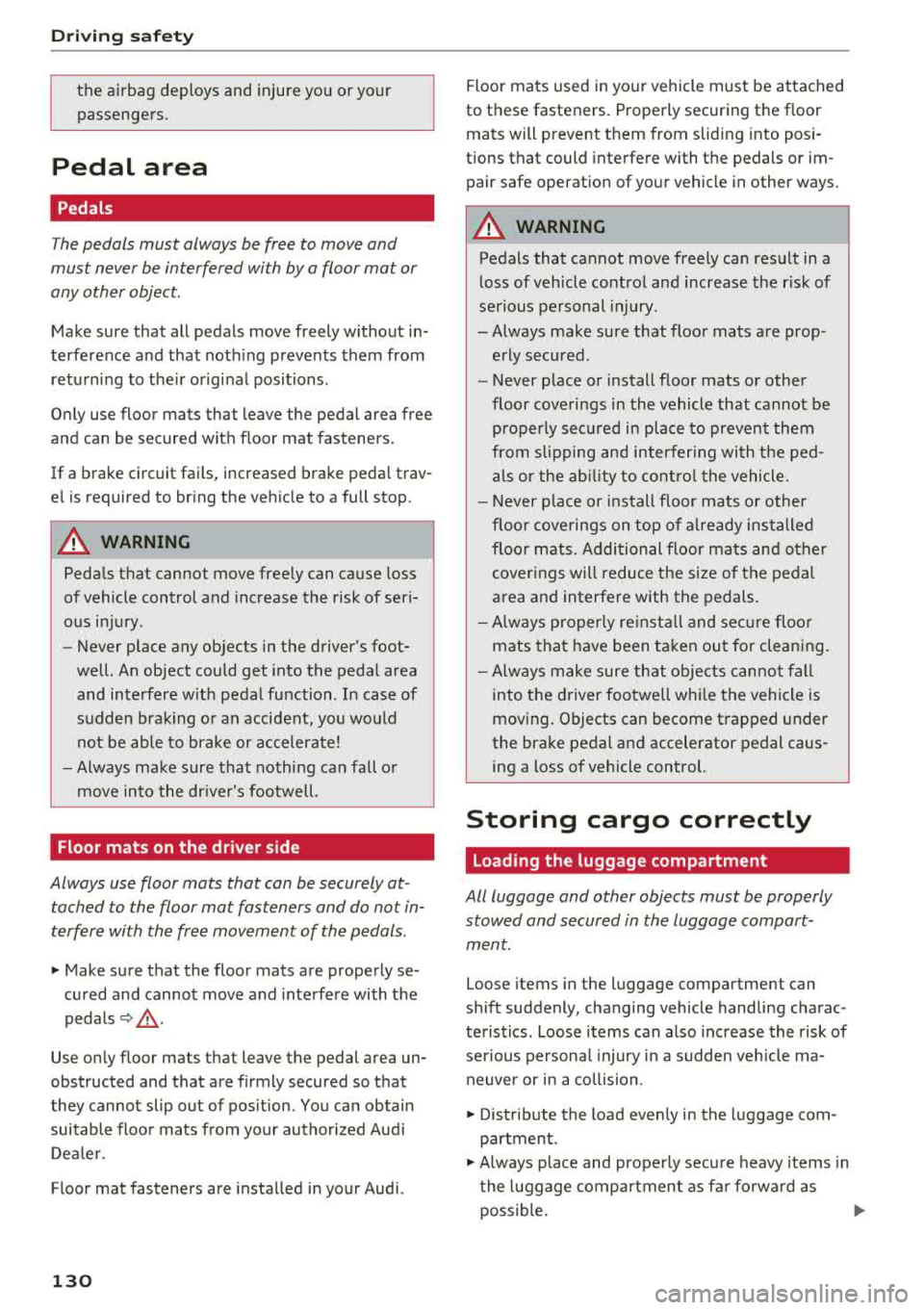
Drivin g saf ety
the airbag deploys and injure you or your
passengers.
Pedal area
Pedals
The pedals must always be free to move and
must never be interfered with by a floor mat or
any other object.
Make sure that all pedals move freely without in
terference and that noth ing prevents them from
returning to the ir original positions .
Only use floor mats that leave the pedal area free
and can be secured with floor mat fasteners.
If a brake circuit fails, increased brake peda l trav
el is required to bring the vehicle to a full stop.
A WARNING
Peda ls that cannot move free ly can cause loss
of vehicle control and increase the risk of seri
ous injury .
- Never place any objects in the driver's foot
well. An object could get into the pedal area
and interfere w ith pedal function . In case of
sudden brak ing or an accident, you would
not be able to brake or accelerate!
- Always make sure that nothing can fa ll or
move into the dr iver's footwell.
Floor mats on the driver side
Always use floor mats that can be securely at
tached to the floor mat fasteners and do not in
terfere with the free movement of the pedals .
"'Make sure that the floor mats are properly se-
cured and cannot move and interfere with the
peda ls ~ ,& .
Use only floor mats that leave the pedal area un
obstructed and that are firmly secured so that
they cannot slip out of pos ition . You can obtain
suitable floor mats from your authorized Aud i
Dea le r.
Floor mat fasteners are installed in your Audi.
130
Floor mats used in your vehicle must be attached
to thes e fasten ers. Properly securing the floor
mats will prevent them from sliding into posi
tions that could interfere with the pedals or im pair safe operation of your vehicle in o ther ways.
A WARNING
Pedals that cannot move freely can result in a
loss of vehicle control and increase the r isk of
serious pe rsonal injury .
- Always make sure that floor mats are prop erly secured .
- Never place or install floor mats or other
floor coverings in the vehicle that cannot be
properly secured in place to prevent them
from s lipping and interfer ing with the ped
als or the ab ility to cont rol the vehicle.
- Never p lace or install floor mats o r other
floor coverings on top of al ready installed
floor mats . Addi tion al floor mats and other
cover ings will reduce the size o f the pedal
area and interfere with the pedals.
- Always properly re install and secure floo r
mats that have been taken out for cleaning.
- Always make sure that objects canno t fall
into the driver footwell while the vehicle is
moving. Objects can become trapped under
the brake pedal and accelerator pedal caus ing a loss of vehicle control.
Storing cargo correctly
Loading the luggage compartment
All luggage and other objects must be properly stowed and secured in the luggage compart
ment.
Loose items in the luggage compartment can
shift suddenly , changing vehicle handling charac
te rist ics . Loose items can also inc rease the risk of
se rious persona l injury in a sudden veh icle ma
neuver or in a collision .
"' Distribute the load evenly in the luggage com
partment .
"'Always place and prope rly secure heavy items in
the l uggage compa rtment as fa r fo rwa rd as
possible .
.,.
Page 133 of 266
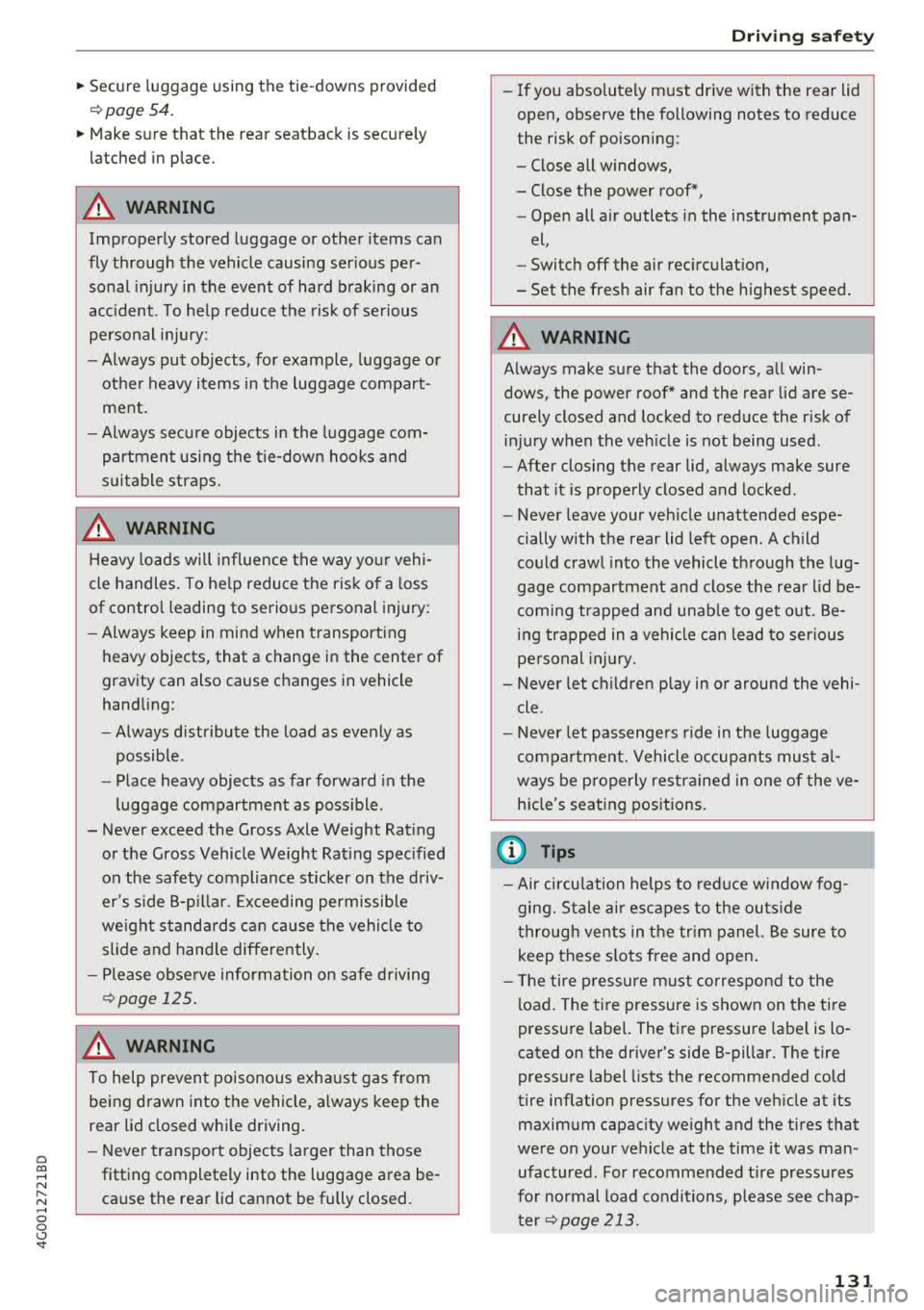
a co .... N
" N .... 0 0 \.J '
~ page 54.
~ Make sure that the rear seatback is securely
latched in place.
A WARNING
Improperly stored luggage or other items can
fly through the vehicle causing serious per sonal injury in the event of hard b raking or an
accident . To help reduce the risk of serious
personal in jury:
- Always put objects, fo r example, luggage o r
other heavy items in the luggage compart
ment.
- Always sec ure objects in the luggage com
partmen t using the tie-down hooks an d
s u itable straps.
A WARNING
Heavy loads wi ll influence the way yo ur vehi
cle handles. To he lp reduce the ris k of a loss
of contro l leading to serio us pe rsonal injury:
- Always keep in mind when transporting
heavy objects, that a change in the center of
gravity can also cause changes in vehicle
handling:
- Always d istribute the load as evenly as
possible.
- Place heavy objects as far forward in the
luggage compartment as poss ible.
- Never exceed the Gross Axle Weight Rating or the Gross Vehicle Weight Rat ing specified
on the safety compliance sticker on the driv
er's side B-p illar. Exceeding permissible
we ight s tanda rds can cause the vehicle to
slide and handle differently .
- Please obse rve information on safe driving
~page 1 2 5.
A WARNING
To help prevent poisonous exhaust gas from
being drawn into the vehicle, always keep the
rear lid closed wh ile driving.
- Never transport objects larger than those
fitt ing completely into the luggage area be
cause the rear lid can not be fully closed.
-
Dri ving saf ety
- If you absolutely m ust dr ive with the rear lid
open, observe the following notes to reduce
the risk of poisoning:
- Close all windows,
- Close the power roof*,
- Open all a ir outlets in the instrument pan-
el,
- Switch
off the air rec irculat ion,
- Set the fresh air fan to the highest speed.
A WARNING
=
A lways make su re that the doo rs, all win-
dows, the powe r roof* and the rea r lid are se
curely closed and locked to reduce the r isk of
i njury when the veh icle is not being used.
- After closing the rear lid , always make sure
that it is properly closed and locked .
- Never leave your veh icle unattended espe
cially with the rear lid left open . A child
could crawl in to the vehicle th rough the lug
gage compartment and close the rea r lid be
coming trapped and unab le to get o ut. Be
ing trapped in a vehicle c an le ad to ser ious
pe rsonal injury.
- Never let children play in o r around the vehi
cle.
- Never let passengers ride in the luggage
compa rtment. Vehicle occupants mus t al
ways be p roperly restrained in one of the ve
h icle's seat ing pos itions.
(D Tips
- Air circulation helps to reduce w indow fog
ging. Stale air esc apes to the outs ide
t hrough vents in the tr im panel. Be sure to
keep these slots free and open.
- The tire p ressure m ust co rres pond to the
load. The t ire pressure is shown on the tire
pressure label. The t ire pressure label is lo
cated on the dr iver's side B-pillar . The tire
pressure label lists the recommended cold
tire inflation pressures fo r the veh icle at its
maximum capac ity weight and the tires that
we re on your vehicle at the time it was man
ufac tured . For recommended t ire pressures
for normal load condi tions, p lease see chap
t er
~page 213.
131
Page 134 of 266
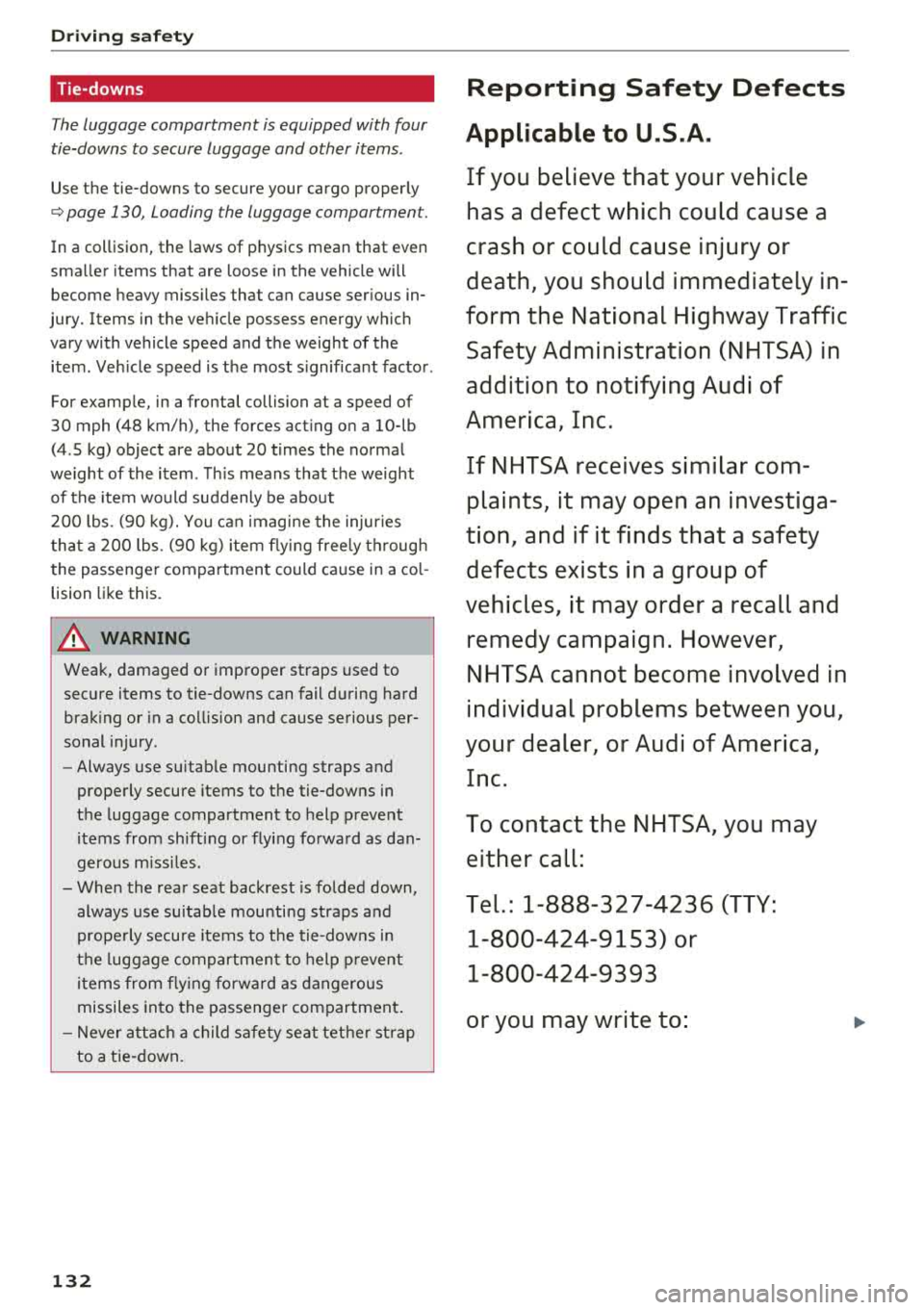
Drivin g saf ety
Tie-downs
The luggage compartment is equipped with four
tie-downs to secure luggage and other items .
Use the tie-downs to secure your cargo proper ly
¢ page 130, Loading the luggage compartment.
In a collision, the laws of p hysics mean that even
sma ller items that are loose in the vehicle will
become heavy missiles that can cause ser ious in
jury . Items in the ve hicle possess energy which
vary with vehicle speed and the weight of the item . Veh icle speed is the most s ignificant factor .
For examp le, in a frontal collision at a speed of
30 mph (48 km/h), the forces act ing o n a 10-lb
(4 .5 kg) object are about 20 t imes the normal
weight of the item . Th is means that the weight
of the item would suddenly be about
200 lbs . (90 kg). You can imagine the injuries
t ha t a 200 lbs . (90 kg) item flying free ly th rough
the passenger compartment could ca use in a co l
lision like this.
A WARNING
Weak, damaged or improper straps used to
secure items to tie-downs can fail d uring ha rd
brak ing or in a collision and cause serious per
sonal injury .
- Always use suitab le mounting straps and
properly secure items to the tie-downs in
the luggage compartment to help p revent
items from shifting or flying forward as dan
gerous missiles .
- When the rear seat backrest is folded down, always use suitab le mounting straps and
prope rly secure items to the tie-downs in
the luggage compartmen t to help p revent
items from flying forw ard as dangerous
missiles into the passenger compartment .
- Never a ttach a child safe ty se at tether strap
to a tie-down.
132
-
Reporting Safety Defects
Applicable to U.S.A.
If you belie ve that your vehicle
ha s a defect whi ch could cau se a
c rash or could cau se injur y or
death, you should immedi atel y in
form the N atio nal Highw ay Traffic
Sa fe ty Admini stration (NHTSA) in
a ddition to n otif yin g Audi of
Am eri ca , Inc.
If NHTS A re cei ves s imilar com
pl aint s, it m ay o pe n an in vestiga
tion , and if it find s that a saf ety
defe cts ex is ts in a group of
ve hicle s, it m ay ord er a re call and
remed y campaign. However,
NHTSA cann ot become in volved in
indi vidu al probl em s between you,
your dealer, or Audi of Am erica,
Inc.
To conta ct the NHT SA, you ma y
either call:
T el.: 1-888-327-4236 (TTY :
1-800-424- 9153) or
1-800-424- 9393
or you may write to:
Page 135 of 266
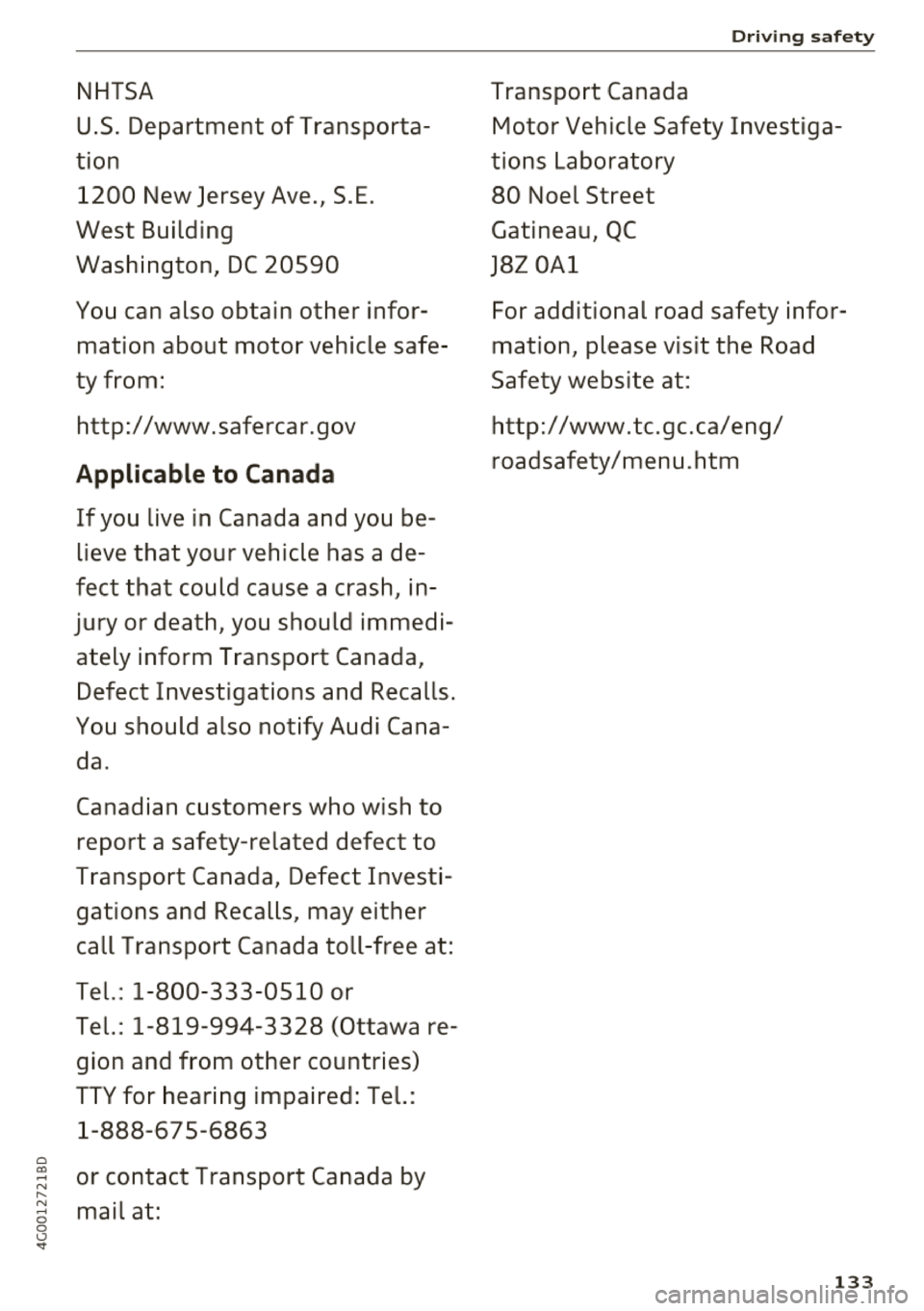
0
NHTSA
U .S. Department of Transporta
tion 1200 New Jersey Ave., S .E.
West Building
Washington, DC 20590
You can also obtain other infor mation about motor vehicle safe
ty from:
http:/ /www.safercar.gov
Applicable to Canada
If you live in Canada and you be
lieve that your vehicle has a de
fect that could cause a crash, in
jury or death, you should immedi
ately inform Transport Canada,
Defect Investigations and Recalls .
You should also notify Audi Cana da.
Canadian customers who wish to
report a safety-related defect to
Transport Canada, Defect Investi
gations and Recalls, may either
call Transport Canada toll-free at:
Tel. : 1-800-333 -05 10 or
Tel.: 1-819-994-3328 (Ottawa re
gion and from other countries)
TT Y for hearing impaired : Tel.:
1 -888-67 5-6863
~ or contact Transport Canada by ,....
8 mail at :
s ..
Driving saf ety
Transpo rt Canada
Motor Vehicle Safety Investiga
tions Laboratory
80 Noel Street
Gatineau , QC
J8Z 0Al
For additional road safety infor
mation, please visit the Road
Safety website at:
http:/ /www.tc.gc.ca/eng/
roadsafety/menu .htm
1 33
Page 136 of 266
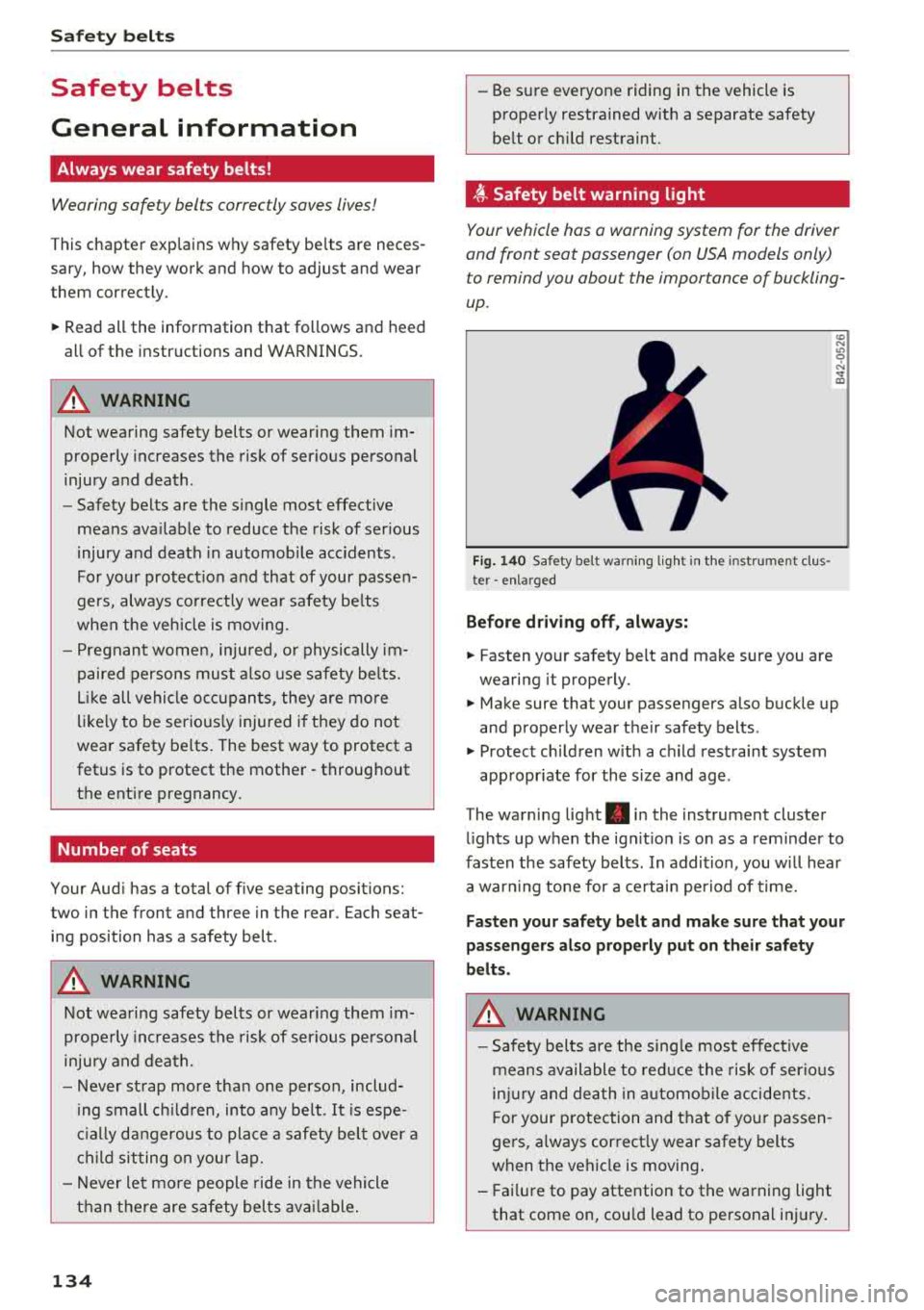
Safety belts
Safety belts
General information
Always wear safety belts!
Wearing safety belts correctly saves lives!
This chapter explains why safety be lts are neces
sary, how they work and how to adjust and wear
them correctly.
.,. Read all the information that follows and heed
all of the instructions and WARNINGS.
A WARNING
Not wearing safety belts or wearing them im
properly increases the risk of serious personal
injury and death.
- Safety belts are the single most effective
means available to reduce the risk of serious
injury and death in automob ile acc idents.
For your protection and that of your passen
gers, always correctly wear safety belts
when the vehicle is moving.
- Pregnant women, injured, or physically im
paired persons must also use safety belts.
Like all vehicle occupants, they are more
likely to be serious ly injured if th ey do not
wear safety belts. The best way to protect a
fetus is to protect the mother
-throughout
the entire pregnancy.
Number of seats
Your Audi has a total of five seating positions:
two in the front and three in the rear. Each seat
ing position has a safety belt.
A WARNING
Not wearing safety belts or wearing them im
properly increases the risk of serious personal
inju ry and death.
- Never strap more tha n one person, includ
i ng small children, into any belt. It is espe
cially dangerous to place a safety belt over a
child sitting on you r lap.
- Never let more people ride in the vehicle
than there are safety belts available.
134 -
Be sure everyone riding in the vehicle is
proper ly restrained with a separate safety
belt or child restraint.
~ Safety belt warning light
Your vehicle has a warning system for the driver
and front seat passenger (on USA models only) to remind you about the importance of buckling
up .
Fig. 140 Safety belt warn ing lig ht in the instrument clus
ter
-enlarged
Before driving off , always:
.,. Fasten your safety belt and make sure you are
wearing it properly .
U) N
"' 9 N
and properly wear their safety belts .
.,. Protect children with a ch ild restraint system
appropr iate for the size and age .
The warning light . in the instrument cluster
lights up when the ign it ion is on as a reminder to
fasten the safety belts . In addition , you will hear
a war ning tone for a certain period of time.
Fasten your safety belt and make sure that your
passengers also properly put on their safety
belts.
A WARNING
-
- Safety belts are the single most effective
means available to reduce the risk of serious
inj ury and death in automobile accidents.
Fo r your protection and that of your passen
gers, a lways correct ly wear safety belts
when t he vehicle is moving .
- Fai lure to pay attention to the warning light
that come on, cou ld lead to personal injury.
Page 137 of 266
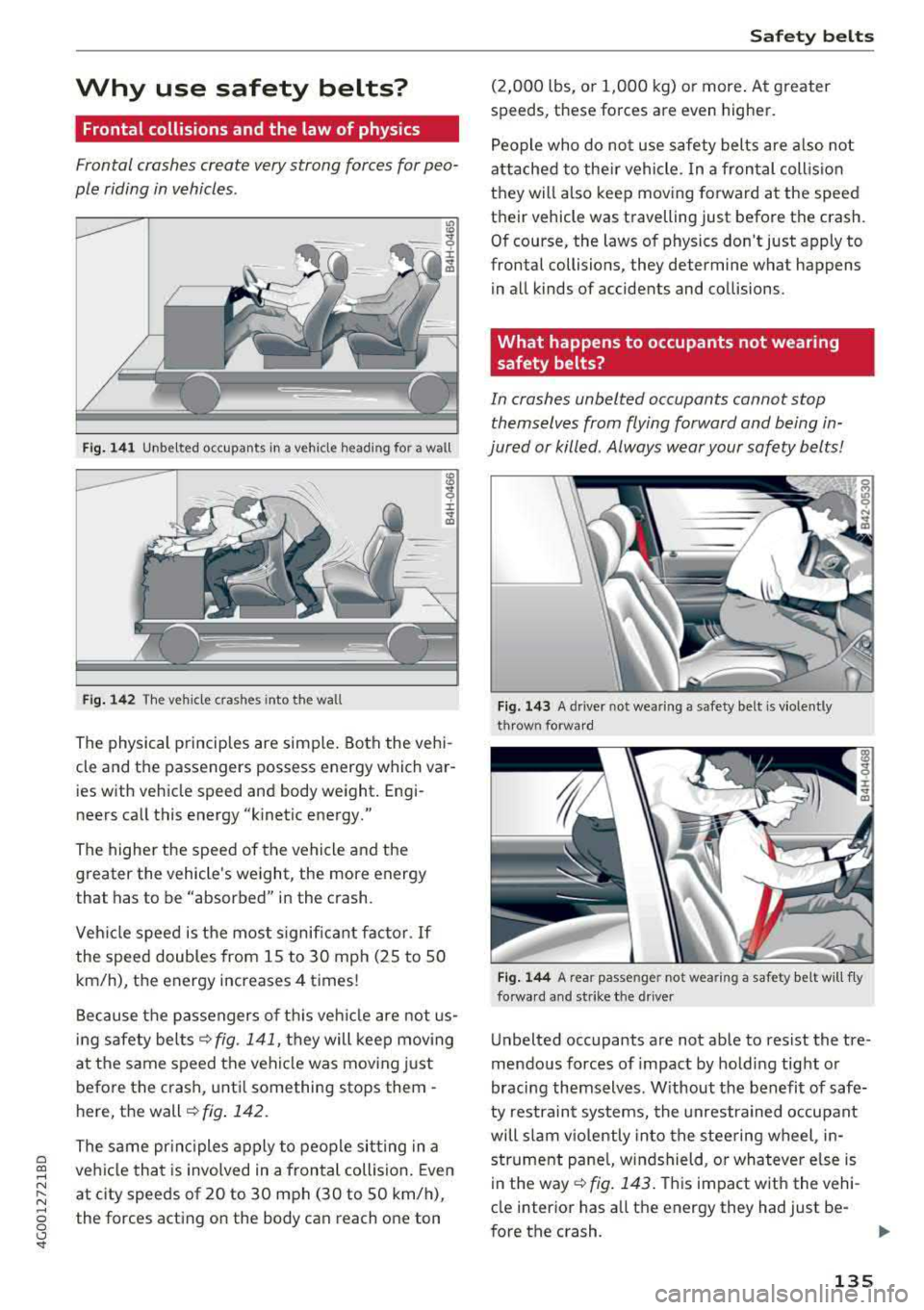
a co ,...,
N
" N ,...,
0 0 \,;J '
Frontal collisions and the law of physics
Frontal crashes create very strong forces for peo
ple riding in vehicles .
Fig. 141 Unbe lted occupants in a vehicle heading for a wall
Fig. 14 2 The vehicle crashes into the wall
The physical principles are simple. Both the vehi
cle and the passengers possess energy which var
ies with vehicle speed and body weight. Engi
neers call this energy "kinetic energy."
The higher the speed of the vehicle and the greater the vehicle's weight, the more energy
that has to be "absorbed" in the crash.
Veh icle speed is the most significant facto r.
If
the speed doubles from 15 to 30 mph (25 to 50
km/h), the energy increases 4 times!
Because the passengers of t his veh icle are not us
ing safety belts
r::!.> fig. 141, they will keep mov ing
at the same speed the vehicle was moving j ust
before the crash, unt il something stops them -
here, the wall
r::!.> fig . 142.
The same pr inc iples apply to people sitting in a
vehicle that is involved in a frontal collision. Even
at city speeds of 20 to 30 mph (30 to SO km/h),
the forces acting on the body can reach one ton
Safety bel ts
(2,000 lbs, o r 1,000 kg) or more . At greater
speeds, these forces are even higher.
People who do not use safety belts are a lso not
attached to the ir vehicle. In a fron tal coll is ion
they will also keep moving forward at the speed
their vehicle was travelling just before the crash.
Of course, the laws of physics don't just apply to
frontal collisions, they determine what happens
in all kinds of accidents and collisions.
What happens to occupants not wearing
safety belts?
In crashes unbelted occupants cannot stop
themselves from flying forward and being in
jured or killed . Always wear your safety belts!
F ig. 143 A driver not wearing a safety belt is violently
thrown forward
Fig . 144 A rear passenger not wearing a safety belt will f ly
forwa rd and strike the driver
Unbelted occupants are not able to resist the tre
mendous forces of impact by holding tight or
bracing themselves. W ithout the benefit of safe
ty restraint systems, the unrestrained occupant
will slam v io lently into the stee ring wheel, in
strument pane l, windshield, o r whatever e lse is
in the way
r::!.>fig . 143. T his impact with the vehi
cle inter ior has a ll the energy they had just be-
fore the crash.
IJI,,-
1 35
Page 138 of 266
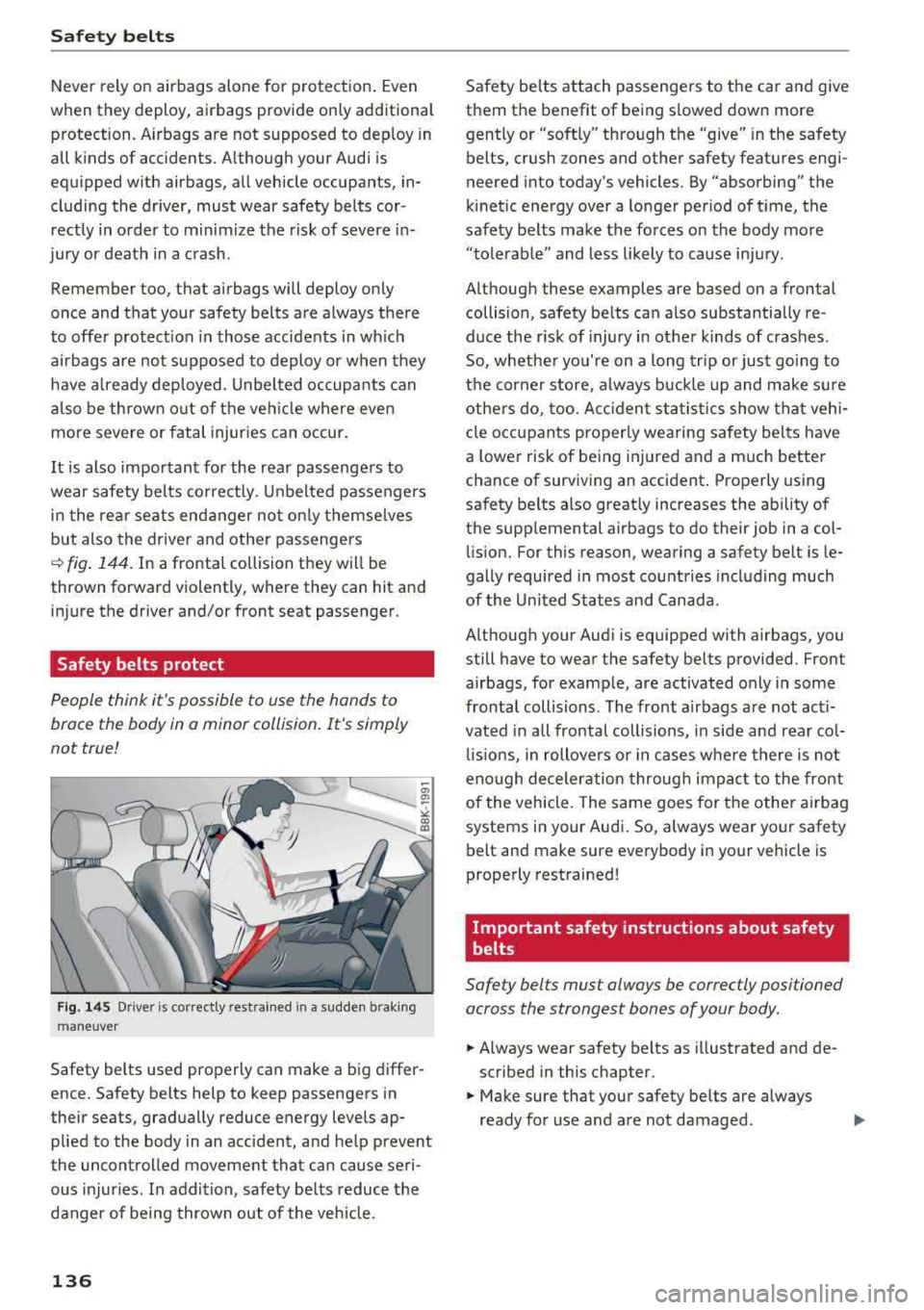
Safe ty belts
Never rely on airbags alone for protection . Even
when they deploy, airbags provide only additiona l
protection. Airbags are not supposed to dep loy in
all kinds of accidents. A lthough your Audi is
equipped w ith airbags, all vehicle occupants, in
cluding the dr iver, must wear safety belts cor
rectly in order to minimize the risk of severe in
jury or death in a crash .
Remember too, that airbags will deploy only
once and that your safety belts are always there
to offer protect ion in those accidents in w hich
airbags are not supposed to deploy or when they
have a lready deployed. Unbel ted occupants can
a lso be thrown o ut of the ve hicle where eve n
mo re severe or fatal injur ies can occur .
It is also important for the rear passenge rs to
wear safety belts co rrectly. Unbel ted passengers
i n t he re ar seats endanger no t on ly themse lves
but also the drive r and other passengers
c::> fig . 144 . In a frontal collision they will be
thrown forward violently, where they can hit and
in jure the driver and/or front seat passenger .
Safety belts protect
People think it's possible to use the hands to
brace the body in a minor collision . It's simply
not true!
F ig . 14 5 Driver is co rrectly restrai ned in a sudde n brak ing
m aneuver
Safety belts used properly can make a b ig d iffer
ence. Safety belts help to keep passengers in
their seats, gradually reduce energy levels ap
plied to the body in an accident, and he lp prevent
the uncont rolled moveme nt that can cause seri
ous injur ies. In addition, safety be lts reduce the
danger of being thrown out of the vehicle .
136
Safety belts attach passengers to the car and g ive
them the benefit of being s lowed down more
gently or "soft ly" thro ugh the "give" in the safety
belts, crush zones and other safety feat ures engi
neered into today 's vehicles. By "absorbing" the
k inet ic energy over a longe r per iod of t ime, the
safety belts make the forces on the body more "tole rab le" and less likely to cause inju ry .
Although these examples are based on a frontal
collision, safety be lts ca n also substantially re
duce the r isk o f injury in ot her kinds of crashes.
So, whethe r you're on a long trip or just going to
the cor ne r store, a lways b uckle up and make s ure
othe rs do, too. Ac ciden t st at ist ics show that veh i
cl e occupants prope rly wearing safety bel ts have
a lowe r risk of be ing injured and a m uch better
chance of surviving an acc ident . Properly using
safety be lts also great ly increases the ability of
the supp lemental airbags to do their job in a col
li sion. For this reason, wearing a safety belt is le
gally required in most countries including much
of the United States and Canada.
Although your Aud i is equipped with airbags, you
still have to wear the safety belts provided. Front
airbags, for examp le, are activated only in some
frontal collisions. The front airbags are not act i
vated in all frontal collisions, in side and rear co l
li sio ns, in rollovers or in cases whe re there is not
eno ugh deceler ation throug h impa ct to the front
of the vehicle . The same goes for the other a irbag
systems in your Audi. So, always wear your safety belt and make sure everybody in your vehicle is
properly rest rained!
Important safety instructions about safety
belts
Safety belts must always be correctly positioned
across the strongest bones of your body.
.,. Always wear safety belts as illustrated and de
scribed in this chapter.
.,. Make sure that your safety be lts are always
ready fo r use a nd a re not damaged .
Page 139 of 266
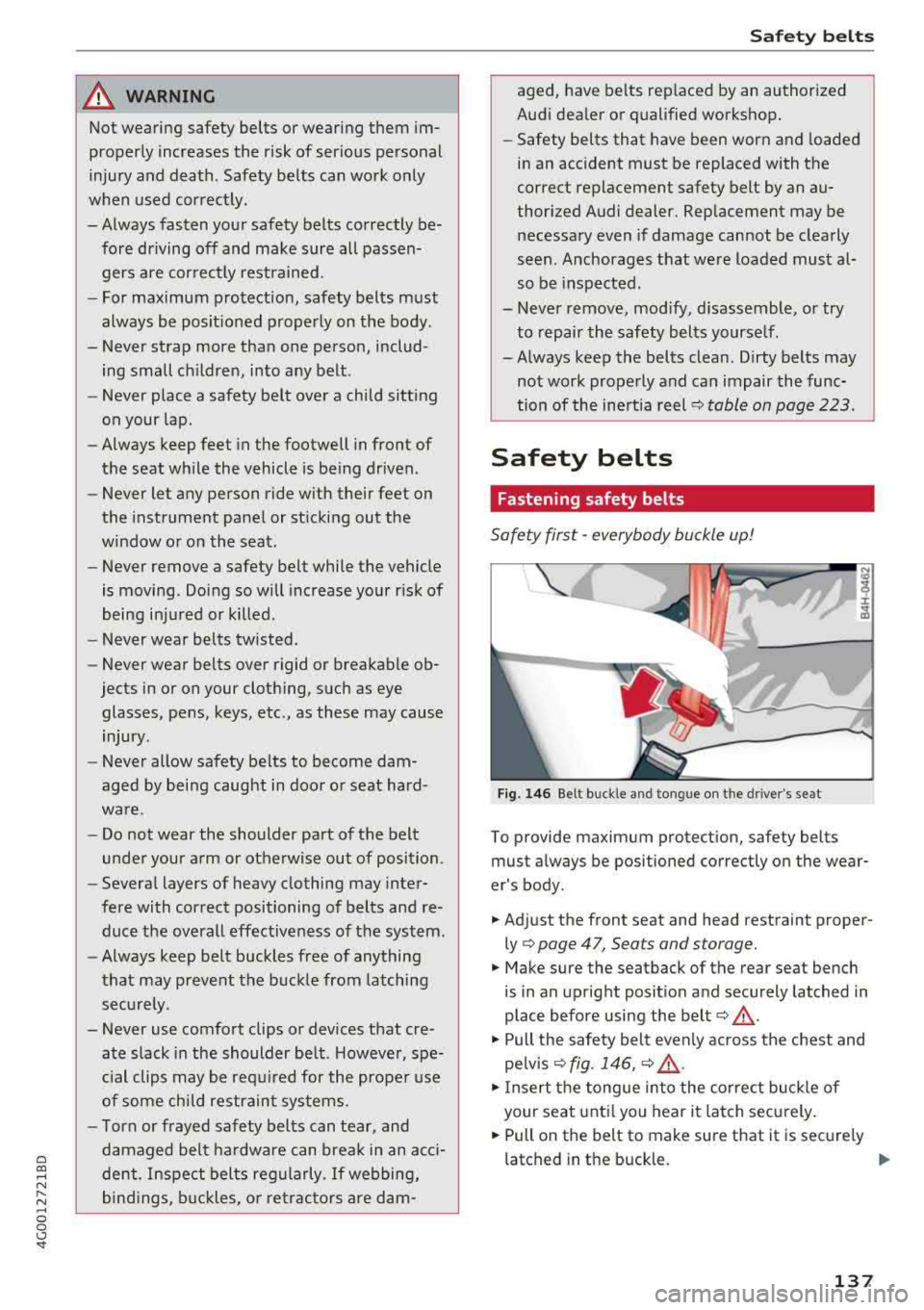
a co ,...,
N
" N ,...,
0 0 \,;J '
Not wearing safety belts or wearing them im
properly increases the risk of serious personal
injury and death . Safety belts can work only
when used correctly.
-Always fasten your safety belts correctly be fore driving off and make sure all passen
gers are cor rect ly restrained.
-For maximum protection, safety belts must
always be posit ioned properly on the body .
-Never strap more than one person, includ
ing small ch ildren, into any belt .
-Never place a safety belt over a child sitting
on your lap.
- Always keep feet in the footwell in front of
the seat wh ile the vehicle is being driven.
- Never let any person ride w ith their feet on
the instrument panel or st icki ng out the
window o r on the seat.
- Never remove a safety belt while the vehicle
is moving . Do ing so will increase your risk of
being injured or k illed.
- Never wear belts twisted.
- Never wear belts over rigid or breakable ob-
jects in or on your clothing, such as eye
glasses, pens, keys, etc ., as these may cause
injury.
- Never allow safety belts to become dam
aged by being caught in doo r or seat hard
ware.
- Do not wear the shoulder part of the belt
under your arm or otherwise out of position .
- Several layers of heavy clothing may inter
fere with correct positioning of belts and re duce the overall effectiveness of the system.
- Always keep belt buckles free of anything
that may prevent the buckle from latching
securely .
-Never use comfort clips or devices that cre
ate slack in the shoulder be lt . However, spe
c ial clips may be requ ired for the prope r use
of some child restraint systems.
-Torn or frayed safety belts can tear, and
damaged belt ha rdware can break in an acc i
dent. I nspect belts regularly.
If webbing,
bind ings, buckles, or re tractors are dam-
Safet y bel ts
aged, have belts rep laced by an authorized
Aud i dea ler or qualified workshop.
- Safety belts that have been worn and loaded
in an accident must be replaced with the
correct replacement safety belt by an au
thor ized Audi dealer. Replacement may be
necessary even if damage cannot be clearly
seen. Anchorages that were loaded must al
so be inspected.
- Never remove, mod ify, d isassemble, or try
to repair the safety belts yourse lf.
-Always keep the belts clean . Dirty belts may
not work properly and can impair the func
tion of th e inert ia reel
q table on page 223.
Safety belts
Fastening safety belts
Safety first -everybody buckle up!
F ig. 146 Belt buckle and tongu e on t he d river' s seat
To provide maximum protect ion, safety belts
must a lways be positioned correctly on the wear
er 's body .
.. Adjust the front seat and head restraint proper
ly
q page 47, Seats and storage.
.. Make sure the seatback of the rear seat bench
is in an upright posit ion and securely latched in
p lace before using the belt
q ,&. .
.. Pull the safety belt evenly across the chest and
pe lvis
q fig . 146, q ,&. .
.. Insert the tongue in to the co rrect buck le of
your seat unt il you hear it latch securely.
.. Pull on the belt to make sure that it is sec urely
latched in the buckle.
..,
1 37
Page 140 of 266
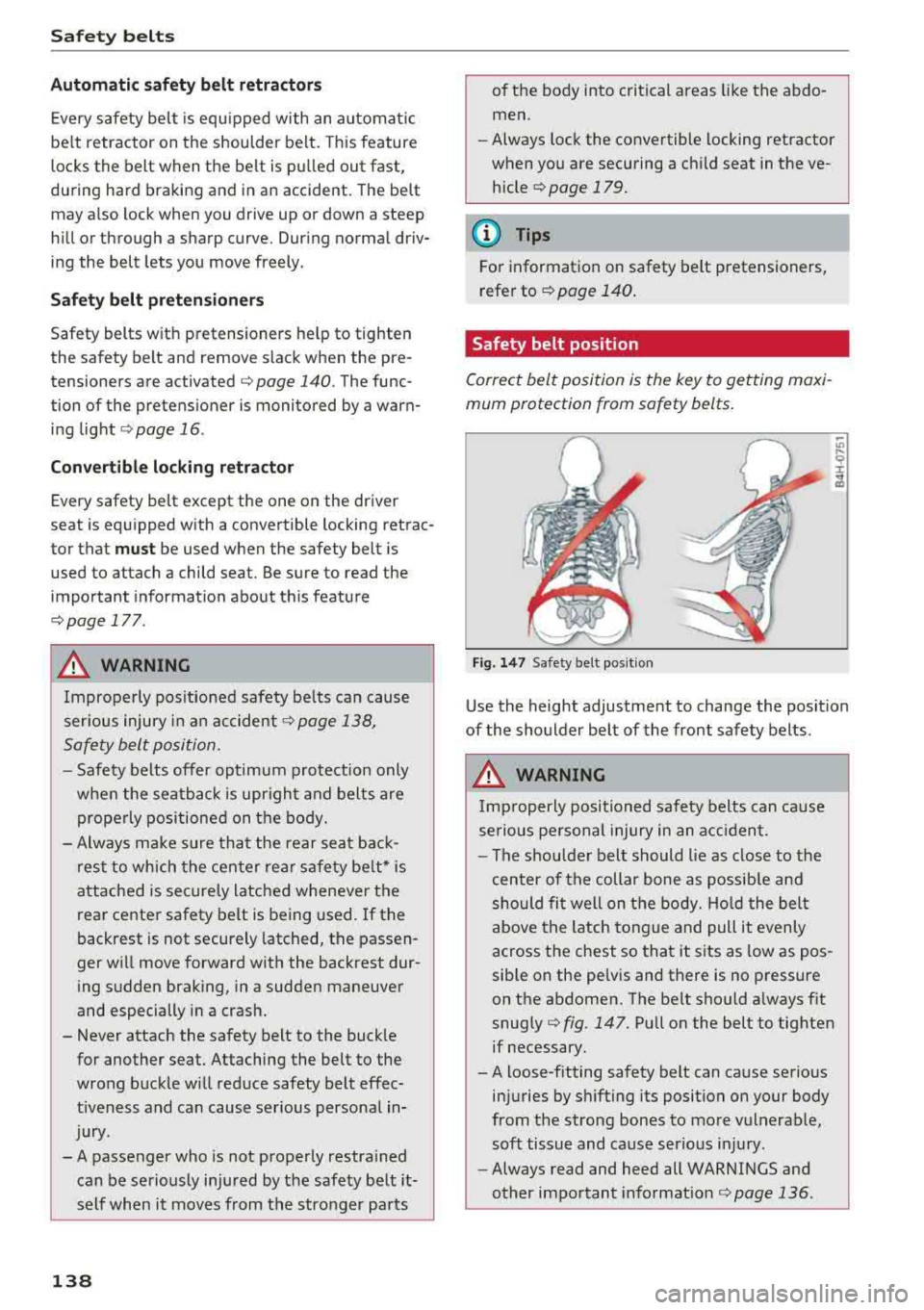
Safe ty belts
Autom ati c s afet y belt retractors
Every safety be lt is equ ipped with an automatic
be lt retractor on the shoulder belt. This feature
locks the belt when the belt is pu lled out fast,
during hard braking and in an accident. The belt may a lso lock when you drive up or down a steep
hill or through a sharp curve. Dur ing normal driv
ing the belt lets you move freely.
Safety belt p ret en sione rs
Safety belts w ith pretensioners he lp to tighten
the safety belt and remove s lack when the pre
tensioners are activated
c;, page 140 . The func
tion of the pretensioner is monitored by a warn
ing light
c;, page 16 .
Convertibl e loc king r etracto r
Every safety belt except the one on the driver
seat is equipped w ith a convertible locking retrac
tor that
must be used when the safety belt is
used to attach a child seat. Be sure to read the
important information about this feature
¢ page 177 .
.&_ WARNING
Improperly pos itioned safety be lts can cause
ser ious injury in an
accident ¢ page 138,
Safety belt position.
- Safety belts offer optimum protection only
when the seatback is upright and belts are
properly positioned on the body.
- Always make sure that the rear seat bac k
rest to which the center rea r safety be lt* is
attached is securely latched whenever the
rear center safety belt is being used. If the
backrest is not securely latched, the passen
ger will move forward with the backrest dur
ing sudden braking, in a sudden maneuver
and especially in a crash.
- Never attach the safety belt to the buckle for another seat. Attaching the belt to the
wrong b uckle wi ll reduce safety belt effec
t iveness and can cause serious person-a l in
jury.
- A passenger who is not proper ly restrained
can be seriously in jured by the safety be lt it
self when it
moves from the stronger parts
138
of the body into critical areas like the abdo men.
- Always lock the convertible locking retractor
when you are securing a child seat in the ve
hicle
,=;, page 179 .
(D Tips
For information on safety belt pretensioners,
refer to
c;, page 140 .
Safety belt position
Correct belt position is the key to getting maxi
mum protection from safety belts .
Fig. 147 Safety belt posit ion
Use the height adjustment to change the posit ion
of the shoulder belt of the front safety belts .
.&_ WARNING
Imp roperly positioned safety belts can cause
serio us pe rsonal injury in an a cc ident.
- The shou lde r belt should lie as close to the
center of the collar bone as possib le and
should fi t well on the body. Ho ld the belt
above the latch to ngue and pull it evenly
across the chest so that it sits as low as pos
sible on the pe lvis and there is no pressure
on the abdomen. The belt should a lways f it
snug ly
c;, fig. 147. Pull on the belt to tighten
if necessary.
- A loose-fitting safety belt can cause serious
injuries by sh ifting its position on your body
from the strong bones to more vulnerable,
soft tissue and cause serious i nju ry .
- Always read and heed all WARNINGS and
other important informat ion
c;, page 136 .